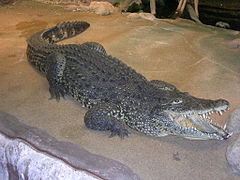- Cuban crocodile
-
Cuban Crocodile 
Conservation status Scientific classification Kingdom: Animalia Phylum: Chordata Class: Reptilia Order: Crocodilia Family: Crocodylidae Genus: Crocodylus Species: C. rhombifer Binomial name Crocodylus rhombifer
Cuvier, 1807The Cuban crocodile (Crocodylus rhombifer) is a small species (2.4 metres average length) of crocodile found only in Cuba's Zapata Swamp and the Isle of Youth, and highly endangered, though it formerly ranged elsewhere in the Caribbean. Fossils of this species have been found in the Cayman Islands[2] and the Bahamas.[3][4]
This species has numerous interesting characteristics that set it apart from other crocodilians, such as its brighter adult colors, rougher, more 'pebbled' scales, and long, strong legs. This species is the most terrestrial of crocodiles, and also possibly the most intelligent. A colony of this species at Gatorland, Florida has also exhibited what is strongly suspected to be pack-hunting behavior, which has prompted much interest in the species, usually kept singly (especially so after such reports).[5]
Contents
Habitat
The Cuban crocodile appears to favor freshwater habitat such as swamps, marshes, and rivers and rarely swims in salt water.[6]
Diet
Small fish, freshwater arthropods, and crustaceans make up the diet of young Cuban crocodiles. Adults of the species feed upon small mammals, fish, and turtles. They have blunt rear teeth, which aids in crushing the shells of their turtle prey. Cuban crocodiles also demonstrate the jumping feeding technique seen in other crocodilians such as the American alligator. By thrusting with their powerful tail, they can leap from the water and snatch small animals from overhanging branches.[7] The Cuban crocodile, while not a particularly large species, is often regarded as the most aggressive New World crocodile[8] and is behaviorally dominant over the larger American crocodile in areas in which the two species coexist[9]. Data regarding attacks on humans is limited, but occurrences are likely rare given the species very small distribution area and separation from human populations.
Conservation
The Cuban crocodile is an endangered species, listed on CITES appendix 1. Its restricted habitiat and range make it very vulnerable. Humans have hunted this species to near extinction. There is still much research to be done on the remaining wild populations. The species is represented in captivity in the United States, where breeding projects are taking place. There have been problems in the past with hybridisation, especially with the American crocodile, which limits the pure gene pool of this species.[7][10]
References
- ^ Targarona, R. R.; Soberón, R. R.; Cotayo, L.; Tabet, M. A.; Thorbjarnarson, J. (2008). "Crocodylus rhombifer". IUCN Red List of Threatened Species. Version 2010.1. International Union for Conservation of Nature. http://www.iucnredlist.org/apps/redlist/details/5670. Retrieved 2010-06-26.
- ^ Morgan, Gary; Franz, Richard & Ronald Crombie (1993). "The Cuban Crocodile, Crocodylus rhombifer, from Late Quaternary Fossil Deposits on Grand Cayman". Caribbean Journal of Science 29 (3-4): 153–164. http://academic.uprm.edu/publications/cjs/VOL29/P153-164.PDF.
- ^ Franz, Richard; Morgan, G, Albury, N & Buckner, S (1995). "Fossil skeleton of a Cuban crocodile (Crocodylus rhombifer) from a blue hole on Abaco, Bahamas". Caribbean Journal of Science 31 (1-2): 149–152.
- ^ Steadman, D. W.; et al. (2007-12-11). "Exceptionally well preserved late Quaternary plant and vertebrate fossils from a blue hole on Abaco, The Bahamas". PNAS 104 (50): 19897–19902. doi:10.1073/pnas.0709572104. PMC 2148394. PMID 18077421. http://www.pubmedcentral.nih.gov/articlerender.fcgi?tool=pmcentrez&artid=2148394.
- ^ Alexander, Marc (2006-01-01). "Last of the Cuban crocodile?". Americas (English Edition) (Organization of American States). ISSN 0379-0940. http://www.thefreelibrary.com/_/print/PrintArticle.aspx?id=141091822. Retrieved 2010-07-09.
- ^ National Zoo
- ^ a b University of Florida
- ^ http://www.markoshea.info/reptileworld_zone2-4.php
- ^ http://www.iucncsg.org/ph1/modules/Publications/ActionPlan3/ap2010_19.html
- ^ Weaver, J. P.; Rodriguez, D.; Venegas-Anaya, M.; Cedeño-Vázquez, J. R.; Forstner, M. R. J.; Densmore, L. D. III (2008). "Genetic characterization of captive Cuban crocodiles (Crocodylus rhombifer) and evidence of hybridization with the American crocodile (Crocodylus acutus)". Journal of Experimental Zoology Part A: Ecological Genetics and Physiology 309A (10): 649–660. doi:10.1002/jez.471.
External links
Extant Crocodilian species Kingdom: Animalia · Phylum: Chordata · Class: Sauropsida · (unranked): Archosauria · Superorder: Crocodylomorpha Family Gavialidae Family Alligatoridae Alligatorinae
(Alligators)Caimaninae
(Caimans)Categories:- IUCN Red List critically endangered species
- Crocodilians
- Crocodylidae
- Fauna of Cuba
- Megafauna
Wikimedia Foundation. 2010.

